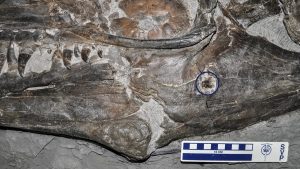
Look into the jaws of a Mosasaurus and you will gaze into a nightmare. The seagoing lizard’s curved teeth stand in a line that point backwards to the throat, an extra set of piercing teeth on the roof of the mouth guaranteeing that any journey into the mosasaur’s mouth was a one-way trip.
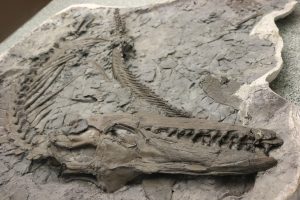
Mosasaurus clearly had the bite of a carnivore. But what did it actually eat? That’s a tale that cannot be told be teeth alone, and, fortunately for paleontologists, a lovely little Mosasaurus provides a partial answer to the question.

In 2008, workers at Alberta, Canada’s Korite International Ammolite Mine uncovered the bones of a marine reptile. Paleontologists from Canada’s Royal Tyrrell Museum quickly excavated the skeleton, but it was only after careful preparation and study that is became clear that they had uncovered a fossil with a complex story to tell. The poor little mosasaur, dead for over 75 million years, was preserved with its last meal and signs that it, too, had become food.
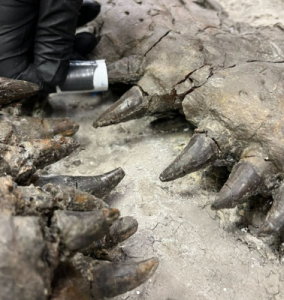
Described by Takuya Konishi and colleagues in the Journal of Vertebrate Paleontology, the marine reptile was a relatively small specimen of Mosasaurus missouriensis. This species was first discovered during the early 19th century, and was recently revised when a long-lost snout piece was finally reunited with the rest of a historic specimen. But the new animal includes parts not previously seen. The Mosasaurus was preserved so delicately that Konishi and coauthors were able to identify the cartilaginous rings of the lizard’s trachea, as well as the sternum. Even though some parts of the back half of the body had gone missing, the rest of the skeleton is stunning in detail.
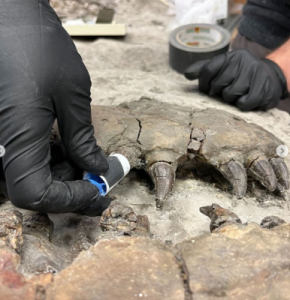
And not all the bones in the block belonged to the Mosasaurus. The paleontologists found various fish bones in the lizard’s gut and beneath the reptile’s skeleton. These were part of what was once a three-foot-long fish called a grinner.
The bones had not been washed in after death. Bite marks on some of the fish bones, as well as the positioning, indicate that the unfortunate fish was the mosasaur’s last meal. Other mosasaur skeletons have yielded gut contents, too, but this is the first time anyone’s found such scraps inside Mosasaurus itself.

Better still, the forensic details of the fish bones may allow paleontologists to figure out how this Mosasaurus ate.
Even though the mosasaur’s head was only two feet long, and shorter than the fish itself, the reptile probably could have swallowed the grinner whole. But the scatter of bones are a clue that the fish met a more violent end. The mosasaur nabbed the fish and chunked it into more manageable pieces, Konishi and colleagues suspect, swallowing each morsel in turn.
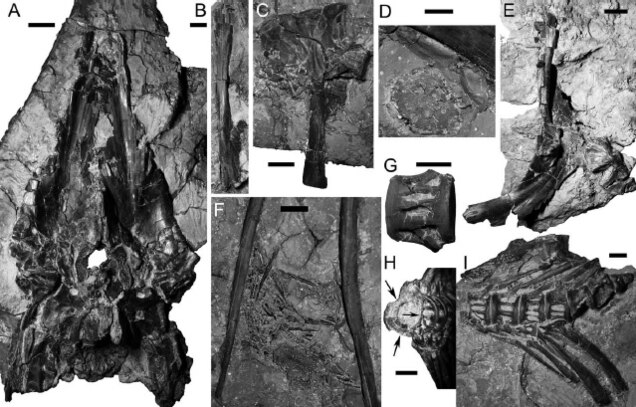
Grinner bones found as cut contents in the Mosasaurus. The hole in the bone marked A is a tooth mark running through the skull. From Konish et al., 2014.
Not all mosasaurs fed this way. Konishi and coauthors point out that a skeleton of a different mosasaur named Prognathodon, found in the same area at the same geologic level, had remains of fish, a sea turtle, and possibly an ammonite in its stomach when it died. Prognathodon was eating hard-shelled stuff, or, was a “Crunch” feeder rather than a “Cut” feeder like Mosasaurus.

The jaws of the mosasaurs seem to match these menu items, Prognathodon with a stouter lower jaw and teeth that show wear from tougher fare. Additional mosasaurs with intact gut contents will be needed to see whether these two individuals really represent the preferred feeding habits of their respective species, but, Konishi and colleagues suspect, differing diets may have allowed these two species of mosasaur to inhabit the same stretch of the sea.

Despite their status as apex predators, though, mosasaurs wound up as meals, too. The Mosasaurus found in the ammolite mine didn’t survive long after dining on grinner, and, soon after settling to the bottom, the lizard’s body was scavenged by at least three sharks. Two left their teeth as calling cards, and a third carved a bite into the mosasaur’s bone. In fact, Konishi and coauthors propose, the large shark may have even contorted the Mosasaurus skeleton into its final position, dragging the tail beneath the body as it chomped along. At least the sharks didn’t have much time to do their work. Sediment soon buried the Mosasaurus, eventually sealing the details of carnivorous Cretaceous life into the rock.





